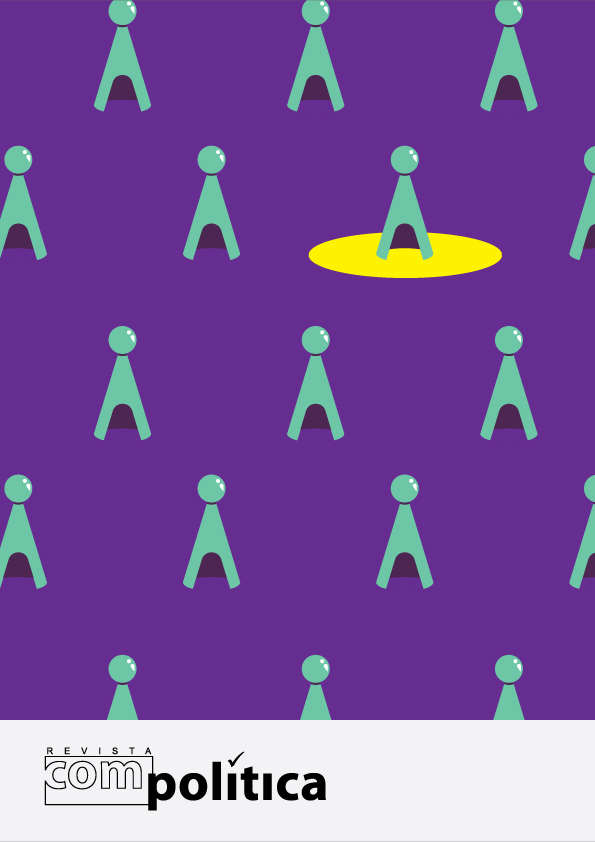The convenience of algorithms
the role of YouTube in the Brazilian political scene
DOI:
https://doi.org/10.21878/compolitica.2020.10.1.333Keywords:
YouTube, algorithm, discourse, politicsAbstract
YouTube has been identified as a platform for the dissemination of conservative ideas, which develop an alternative model of influence that favors the promotion of issues with a conservative bias in opposition to the notions of social justice and human rights. From a survey of the top-recommended videos on YouTube during the 2018 Brazil elections, the study points out the ways this platform worked, the activity of the algorithms and the strategies of the humans or robots actants in Brazilian electoral political scene, in which predominates the strong presence of the themes related to Jair Bolsonaro’s presidential campaign and the conservative discourse that marked his trajectory to the presidency of Brazil.
References
ARAUJO, T.; NEIJENS, P.; VLIEGENHART, R. Getting the word out on Twitter: The role of influentials, information brokers and strong ties in building word-of-mouth for brands. International Journal of Advertising, v. 36, n. 3, pp. 496-513, 2017. Disponível em: http://dx.doi.org/10.1080/02650487.2016.1173765
BIMBER, B. Digital Media in the Obama Campaigns of 2008 and 2012: Adaptation to the Personalized Political Communication Environment. Journal of Information Technology & Politics v. 11, n. 2, pp. 130-150, Maio de 2014. Disponível em: https://www.researchgate.net/publication/272532756_Digital_Media_in_the_Obama_Campaigns_of_2008_and_2012_Adaptation_to_the_Personalized_Political_Communication_Environment Acesso em: 05/06/2019.
BONAZZI, T. Conservadorismo. In: BOBBIO, Norberto et al, (orgs). Dicionário de Política. Brasília, Editora Universidade de Brasília, 1993.
BOZDAG, E. (2013). Bias in algorithmic filtering and personalization. Ethics and Information Technology, 15(3), 209–227. Disponível em https://doi.org/10.1007/s10676-013-9321-6
BRAGA, S.; CARLOMAGO, M. Eleições como de costume? Uma análise longitudinal das mudanças provocadas nas campanhas eleitorais brasileiras pelos impactos das tecnologias digitais (1998-2016). In: MAIA, R.; PRUDÊNCIO, K.; VIMIEIRO, Ana C. Democracia em ambientes digitais. Eleições, esfera pública e ativismo. Salvador: EDUFBA, 2018.
CODATO, A.; BOLOGNESI, B.; ROEDER, K. M. A nova direita brasileira: uma análise da dinâmica partidária e eleitoral do campo conservador. In: CRUZ, Sebastião Velasco e; KAYSEL, André; CODAS, Gustavo (Orgs.) Direita, volver! O retorno da direita e o ciclo político brasileiro. São Paulo: Editora Fundação Perseu Abramo, 2015.
CASTELLS, M. O poder da comunicação. 2ª Ed. Rio de Janeiro/ São Paulo: Paz e Terra, 2017.
COVINGTON, P., ADAMS, J., & SARGIN, E. Deep Neural Networks for YouTube Recommendations. In Proceedings of the 10th ACM Conference on Recommender Systems - RecSys ’16 (pp. 191–198), 2016. Boston, Massachusetts, USA: ACM Press. https://doi.org/10.1145/2959100.2959190
GIBBS, M.; et al. #Funeral and Instagram: death, social media, and platform vernacular. Journal Information, Communication & Society. Volume 18, 2015. Issue 3. Disponível em: https://opus.lib.uts.edu.au/bitstream/10453/69284/1/Gibbs-Meese-Nansen-Arnold-Carter-full-text_libre.pdf
GOMES, W.; et al. “Politics 2.0”: A campanha on-line de Barack Obama em 2008. Rev. Sociologia Política, Curitiba, v. 17, n. 34, p. 29-43, out. 2009. Disponível em: http://www.scielo.br/pdf/rsocp/v17n34/a04v17n34.pdf
GREEN, J; BURGESS, J. You Tube e a revolução digital. São Paulo: Aleph, 2009.
LEWIS, R. Alternative Influence: Broadcasting the Reactionary Right on YouTube. Data & Society Research Institute. 18/09/2018. Disponível em: https://datasociety.net/wp-content/uploads/2018/09/DS_Alternative_Influence.pdf
MEDIA OWNERSHIP MONITOR BRASIL. Disponível em: <http://brazil.mom-rsf.org/br/proprietarios/empresas/detail/company/company/show/grupo-jovem-pan/> Acesso em: 22 dez. 2019.
MESSENBERG, D. A direita que saiu do armário: a cosmovisão dos formadores de opinião dos manifestantes de direita brasileiros. Sociedade e Estado, v. 32, n. 3, p. 621–648, dez. 2017.
NEWMAN, N. Reuters Institute Digital News Report 2019. p. 156, 2019.
PARISER, Eli. O filtro invisível: o que a internet está escondendo de você. Rio de Janeiro: Zahar, 2012
RIEDER, B.; MATAMOROS-FERNÁNDEZ, A.; COROMINA, Ò. From ranking algorithms to ‘ranking cultures’: Investigating the modulation of visibility in YouTube search results. In: Convergence: The International Journal of Research into New Media Technologies. 24(1), 50–68, 2018. Disponível em: https://drive.google.com/open?id=1uOV8J-f6jgYJFGIlcP3bazp-O5Z6RmfA
SILVA, F. C. G. da. A Propaganda eleitoral pela Internet, in I Seminário de Direito Eleitoral: Temas relevantes para as eleições de 2012, Rio de Janeiro, EMERJ, 2012. Disponível em: http://www.emerj.tjrj.jus.br/serieaperfeicoamentodemagistrados/paginas/series/7/seriemagistrado7.html. Acesso em: 20/12/2019
TATAGIBA, L.; TRINDADE, T.; TEIXEIRA, A. C. C. Protestos à direita no Brasil (2007-2015). In: CRUZ, Sebastião Velasco e; KAYSEL, André; CODAS, Gustavo (Orgs.) Direita, volver! O retorno da direita e o ciclo político brasileiro. São Paulo: Editora Fundação Perseu Abramo, 2015.
YOUTUBE INSIGHTS 2017. Disponível em: <https://www.thinkwithgoogle.com/intl/pt-br/youtubeinsights/2017/>. Acesso em: 22/12/2019.
Downloads
Published
How to Cite
Issue
Section
License
Autores mantém os direitos autorais e concedem à revista o direito de primeira publicação, com o trabalho simultaneamente licenciado sob a Creative Commons Attribution License que permite o compartilhamento do trabalho com reconhecimento da autoria do trabalho e publicação inicial nesta revista.



